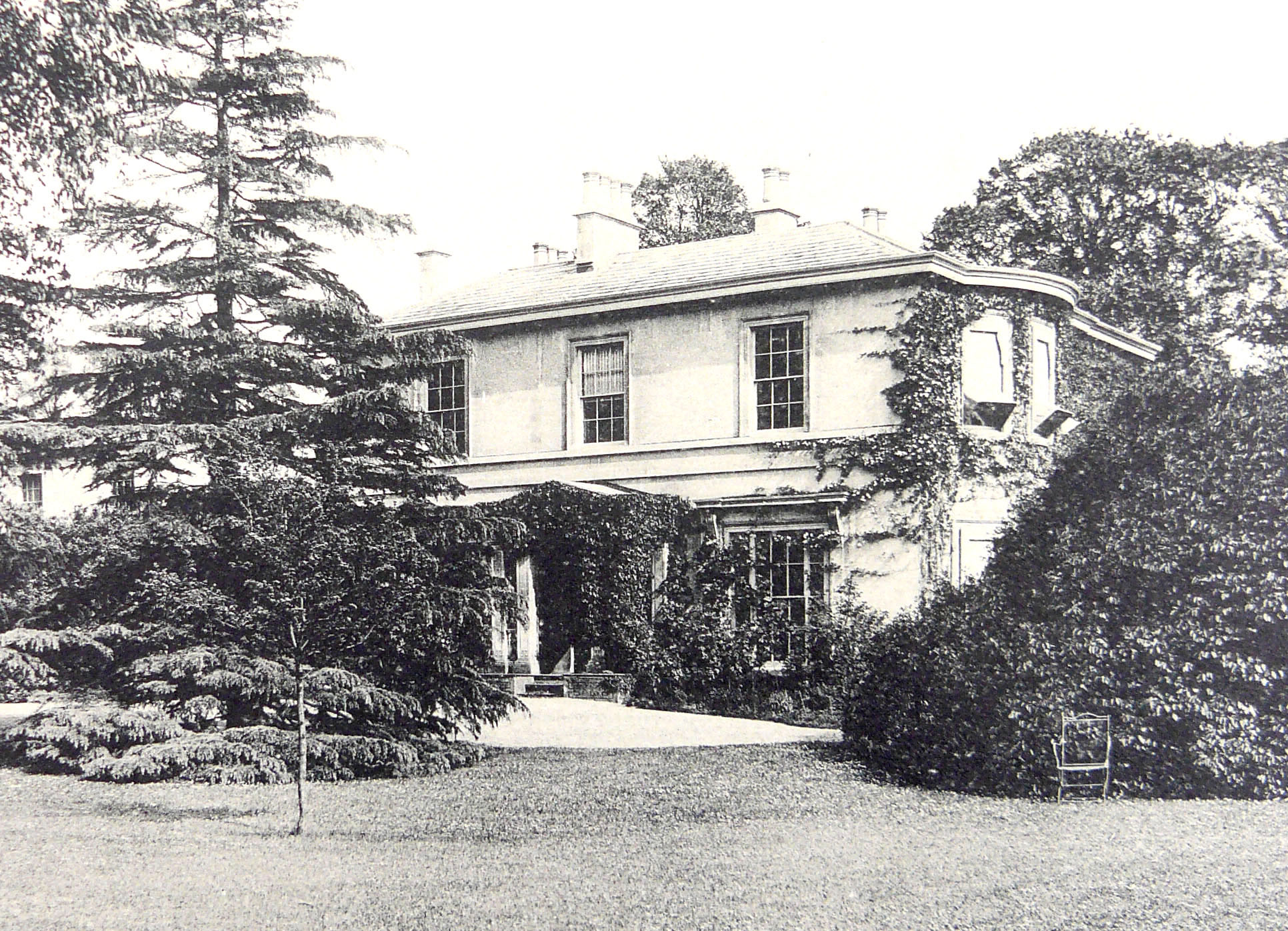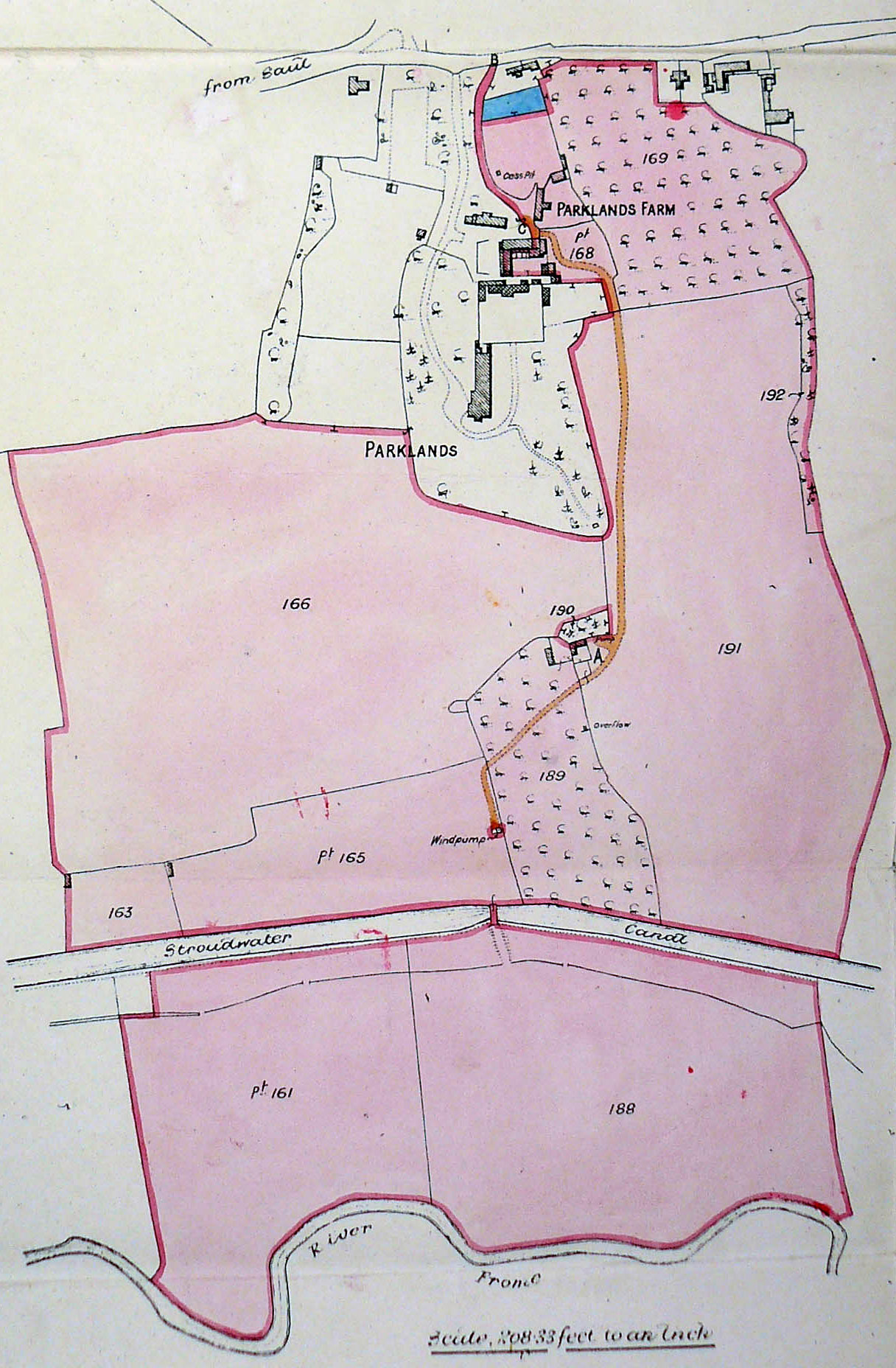Hugh Conway-Jones outlines the story of the Parklands Estate through which the canal passes to the west of the Bristol Road.


The Parklands Estate comprised a big house and a farm house on the outskirts of the village of Whitminster with 60 acres of fields running down the south-facing slope to the River Frome below. What we now call Occupation Bridge was built to provide access to the estate’s lower meadows adjoining the river. The towpath was not fenced, and the canal was a source of drinking water for grazing animals. Over the years, the estate was owned by a succession of wealthy men who played their part in local affairs.
The big house with a fine view over the Frome valley was built c1823 by Richard Martin, and his brother William occupied the adjoining farm house. Martin had been a banker in Stroud and then became a wine and spirits merchant importing through Gloucester Docks. He joined the Stroudwater Committee in 1839 and regularly supplied bottles of port, sherry and bucellas for their dinners.
Later the estate was owned by John Grey, a junior member of a well-known land-owning family from County Durham who employed six household servants. He soon became a local magistrate and happily made his land available for local events. These included annual treats for local school children, involving games and refreshments. On other occasions, archery matches were held in the Home Field with croquet on the house lawn. John Grey took little interest in the farm side of the estate, allowing his coachman to occupy the farm house. In 1869, a hay rick beside the canal was discovered to be on fire. It was cut to provide ventilation, but 30 to 40 tons ended up a smouldering mass.
In the early twentieth century, the estate was bought by William Grey Robinson, a nephew of John Grey and a life-long bachelor who lived in the house with his two sisters. He became a regular rider with the Berkeley hunt, he served on the parish council and he became a magistrate. In 1906, passing bargemen complained that the trees alongside the canal were so overhanging that they obstructed traffic, and the Stroudwater Company asked him to have them cut back. By this time, the farm part of the estate was in the hands of farmer George Pockett, later followed by his son Robert.


In the 1940s, the estate was formally split into two parts. The house became a convalescent home and later a children’s home. The farm was sold to tenant Robert Pockett, who was followed by his son Michael.
In the 1960s, the farm was stocked with cattle mainly for producing milk and some beef. Most of the fields had access to the canal, which gave the animals a good source of drinking water. The canal bank did get damaged in places, and repairs were sometimes needed. In the one field that was not adjacent to the canal, there was a spring that fed a pond. This had a hard stony bottom to prevent the cows making it a mud bath. Twice a day the cows had to walk up to the farm for milking, which they did readily when given a shout.
Each spring, some part of the land was allowed to grow hay. In the summer, this was cut by a contractor, and when appropriate it was turned by a tedder attachment to the farm’s tractor. Then when the hay was dry, the whole family was expected to join in with gathering the hay and moving it to store for the winter.
The farm had two orchards, one near the farmhouse and the Lower Orchard beside the canal. Both were full of trees, although some were very old and not producing much. Most of the trees were growing fruit for making cider or perry and only a few were producing fruit for eating. The grass in the orchards was grazed at times, but the cattle preferred the grass in the open fields. At harvest time, a long pole was used to shake the branches, and the whole family was expected to join in collecting the fallen fruit. This was taken by trailer up to the farm, where it was collected by one of the big drink producers. For more about the Lower Orchard, visit Pockett's Orchard.
Very occasionally, the River Frome over-topped its banks and flooded the lower fields to a depth of several feet. When the flood subsided, it left behind a line of rubbish, and the boys were expected to help clear it up so the returning animals did not come to any harm. The only access to these fields was via Occupation Bridge over the canal, and this was regularly used by the cows and by the farm’s tractor and trailer. The bridge had a very steep approach on the south side which was a good spot for sledding in the winter. The canal under the bridge was particularly deep, and Michael dived in from the bridge parapet. Local fishermen kept a punt near Stonepits Bridge, and the two brothers occasionally borrowed it to enjoy a paddle along the canal.
In recent years, the big house was converted to apartments, the farm house is now a private house and the land near the main road has been developed for housing.
Big house at Parklands shown on Bryant’s map of 1824.
Property deeds for Parklands in C/DC/F/37/1.
Richard Martin supplying wines etc from Glo Jnl 23 Jun 1838 p3; D1180/1/4 & /5.
John Grey’s events from Str Jnl 23 Jan 1875; Str News 18 Jul 1873.
Rick fire from Stroud News 6 Aug 1869 p8.
W G Robinson’s activities from Str News 24 Jan 1902 p2; Str News 2 Dec 1904 p8; Str News 3 May 1907 p5.
Need to clear overhanging trees from D1180/9/11 p258.
Pockett family from C/DC/F/37/1, directories and census returns.
Memories of the 1960s from Richard Pockett, second son of Robert.